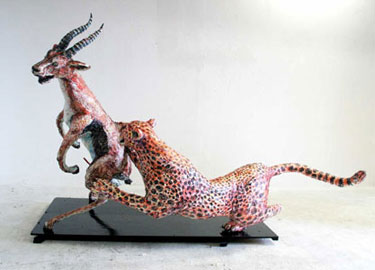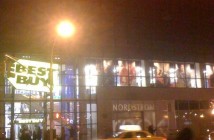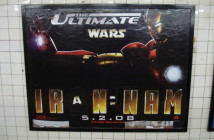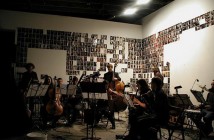...Yet man to-day is the same man that drank from his enemy's skull in the dark German forests, that sacked cities, and stole his women from neighboring clans like any howling aborigine. The flesh-and-blood body of man has not changed in the last several thousand years. Nor has his mind changed. There is no faculty of the mind of man to-day that did not exist in the minds of the men of long ago.
Starve him, let him miss six meals, and see gape through the veneer the hungry maw of the animal beneath. Get between him and the female of his kind upon whom his mating instinct is bent, and see his eyes blaze like an angry cat's, hear in his throat the scream of wild stallions, and watch his fists clench like an orang-outan's. Maybe he will even beat his chest. Touch his silly vanity, which he exalts into high-sounding pride -- call him a liar, and behold the red animal in him that makes a hand clutching that is quick like the tensing of a tiger's claw, or an eagle's talon, incarnate with desire to rip and tear.
- Edgar Rice Burroughs, Excerpt from notes for "Return of Tarzan"
The world is on the brink of collapse. Any moment we could all be back in the wilderness fighting for survival. A mutually beneficial society contradicts being instinctually wired to look out for ourselves and act on our immediate desires. Our cultural stability requires these two forces are kept in delicate balance.
Hollywood happily profits from pointing out this precarious position. In the next summer blockbuster, the earth could warm at an alarming rate and flood the earth or alien contact will result in the White House and the Chrysler building being obliterated from a ship's laser beam. Where would that leave our daily construct of going to the bank or the grocery store? It wouldn't take much for the comfortable life we know to succumb to primal instinct, self preservation, and the struggle for food and shelter.
I was reminded of these ideas walking into the Sampson Projects Gallery and looking at Rune Olsen's latest sculpture. It is the savage life of the animal kingdom in action. It's our unconscious fantasies acted out in the day to day life of the wild.
Life-sized apes fornicating, one on top of another, while a third curiously reaches for their genetalia, greet the viewer entering the gallery. Entitled "Hear Me Roar", the title suggests the underlying dominance of this act, the victory in having been chosen as a mate over all suitors. Viewers can immediately relate to our close genetic peer, the ape, and the biological act of procreation. Olsen draws us into this humorous diorama only to casually hint at the source of our own behavior.
I couldn't help but get down to their level to more closely examine the painstaking construction. The material, masking tape and markers, on top of newspaper, lead to a gesturally imperfect interpretation of the forms. The artist seems to be leaving us with an expression of the event, imperfect and raw. It's not that these monumental sculptures aren't accurate, far from it, but the layered armature of newspaper wrapped in tape can at best provide just a sketch of the physical creatures. Olsen wants to limit himself to a material that will not easily represent the anatomy, in order to avoid a literal interpretation. Instead, they capture an emotional level of these interactions. It's argued that all basic emotions are derived from the primitive acts of survival. Fear stems from the flight mechanism, anger from fighting. In the wild it is a fundamental core of their existence, not a decision with regard to outside influences.
The second piece, titled "Take My Breath Away", is a dynamic still frame of a cheetah with one claw embedded in the leg of an antelope, who is in the middle of a jumping escape. Both animals have jaws open, the cheetah preparing to deliver a bite to the jugular and the antelope in wide-eyed fright.
Using the same scribbling lines of crayon colors, these marks are an allusion to the unconscious itself, imprinted on the surface. Except for the eyes, they are irreverent coloring book representations of these instincts. Olsen chose to use mannequin eyes, as an associative device and our point of entry, to this unchecked primal emotion we also possess.
In killing the prey to satisfy his own survival, the predator fulfills his desire for food while at the same time contemporarily referencing a song from Top Gun, in the same playful spirit as the sculptures construction.
Olsen is concerned with the actions these animals take and the motives behind them, less about simulating the beauty of the creature. What emotions driven by instinct exist in these wild animals and all creatures? Startlingly, we are more connected to this behavior than we are sometimes willing to admit. The work may be appeasing a voyeuristic desire to experience these wild emotions, perhaps connecting with something deep inside us for a return to the unchecked insatiable id.
The real struggle in our daily life is to inhibit these desires, to listen to the superego and think of the consequences, make sacrifices for the sake of our own survival.
Olsen suggests that perhaps underneath we are all just savage, wild animals, fighting and fucking.
Links:
Samson Projects
"Jeffrey Gibson & Rune Olsen: the urge that binds" is on view December 13, 2004 - January 15, 2005 at Samson Projects.
All images are courtesy of the artist and Samson Projects.
Jason Dean is an occasional contributor to Big, Red & Shiny.




